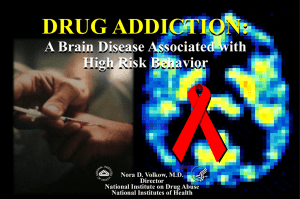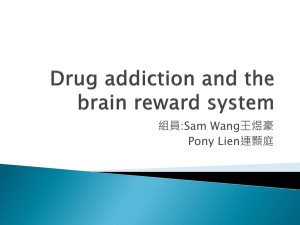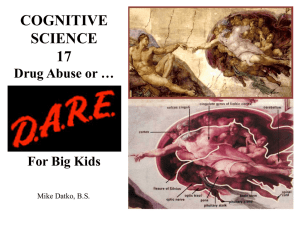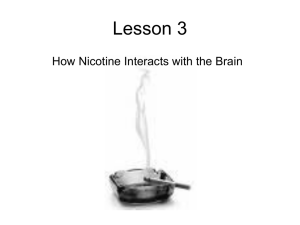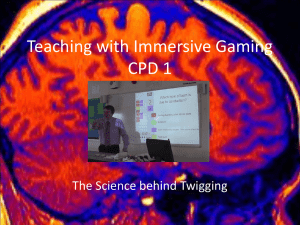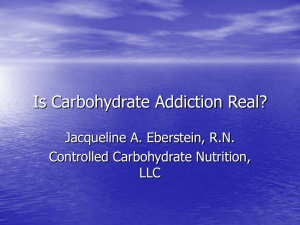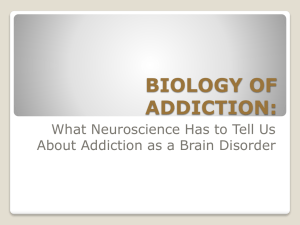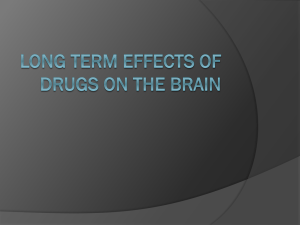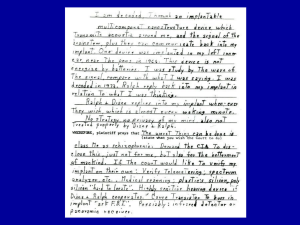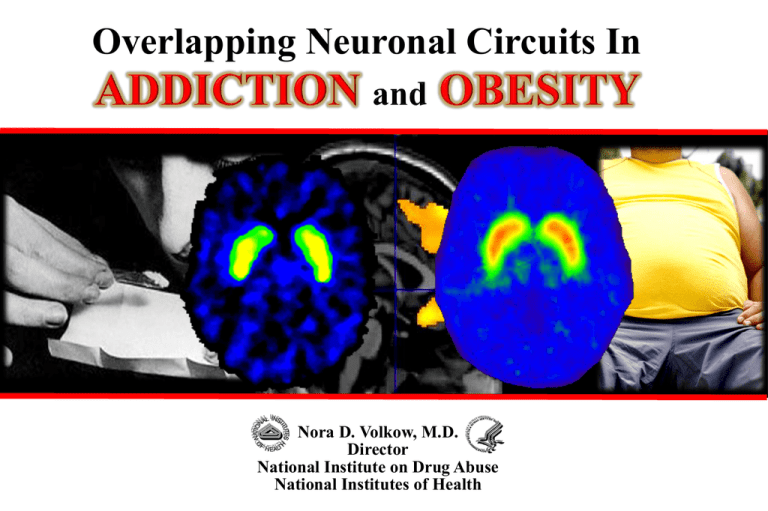
Overlapping Neuronal Circuits In
Nora D. Volkow, M.D.
Director
National Institute on Drug Abuse
National Institutes of Health
Signals that Control:
Drug Consumption
Food Consumption
Reward
Reward
Dopamine, Cannabinoids,
Serotonin, Opioids
Dopamine, Cannabinoids,
Serotonin, Opioids
Hypothalamus
(Nutritional need)
Hypothalamus
Ventral tegmental area
(Reward)
Ventral tegmental area
(Reward)
Homeostatic factors
Leptin, Insulin, Ghrelin, PYY
Dopamine Neurotransmission
VTA/SN
AMPHETAMINE
% of Basal Release
nucleus
accumbens
0
1
2
3
4
Time After Amphetamine
5 hr
FOOD
200
% of Basal Release
frontal
cortex
1100
1000
900
800
700
600
500
400
300
200
100
0
150
100
50
0
Empty
Box Feeding
0
60
120
180
Time (min)
Di Chiara et al.
Reward Circuit in Addiction
and in Obesity
NAcc
TYROSINE
DOPA
DOPA
DA
DA
DA
DA
DA
raclopride
R
R
DA
DA
DA
DA
DA
R
R
R
VP
DA
DA
methylphenidate
DA
DA
DA DA
R
raclopride
Self-Reports
(0-10)
DA
DA
TYROSINE
REWARD
“High”
10
8
6
4
2
0
-2 -10 0 10 20 30 40
Change in Dopamine
Bmax/kd (Placebo - MP)
Volkow et al., JPET 291(1):409-415, 1999.
Low
Cocaine abuser
20
14%
15
10
3%
5
0
Control
Abuser
P < 0.001
10
8
6
4
2
Control Abuser
(1-10)
Control subject
Placebo
MPH
Striatal Activation to
Food Reward
in Obese and Lean Ss
P < .001
25
Self-report High
High
% Change Bmax/Kd
Reactivity of Dopamine System
to Drug Consumption in
Actively Using Addicted Subjects
Active cocaine abusers showed a marked
reduction in MPH-induced DA increases
and in its reinforcing effects
High-BMI participants showed
decreased response in caudate in
response to consummatory food reward
compared with low-BMI participants
Stice et al., J Abnormal Psychology 2008.
Memory Circuit in Addiction
and in Obesity
In rats when a neutral stimuli is
repeatedly paired with the drug
Amyg
MEMORY/
(conditioned), it elicits DA
LEARNING
increases and reinstates
drug self- administration
In training the cue was
paired with cocaine
DA Release NAc
•
Hipp
In training the cue was not
paired with cocaine
Auditory cue
Philipps et al Nature 422, 614-618.
Here we tested if conditioned stimuli increase DA in
addicted subjects and its relationship to drug craving
[11C]Raclopride Binding In
Cocaine Abusers Viewing a
Neutral and a Cocaine-Cue Video
[11C]Raclopride Binding in
Food Deprived Controls (n=16)
During Neutral and Food Cues
1.5
0
ml/g
Neutral video
Neutral:
Subjects were
asked to
describe their
family genealogy
Viewing a video of cocaine scenes
decreased specific binding of
[11C]raclopride presumably
from DA increases
Volkow et al J Neuroscience 2006.
Food Cue:
Bmax/Kd decreased with
exposure to food-cues
Volkow, et al., Synapse 2002.
Motivation & Executive
Control Circuits
•
•
EXECUTIVE
FUNCTION
PFC
INHIBITORY
CONTROL
In addicted subjects or in
obese subjects, are the
changes in DA function linked
with disruption of frontal
activity?
Used multiple tracers to
evaluated in the same subject
DA D2 receptors and brain
glucose metabolism (marker
of brain function).
ACG
OFC
SCC
MOTIVATION/
DRIVE
DA DA
DA
DA DA
DA
DA
DA D2 Receptors
signal
Metabolism
Dopamine D2 Receptors are Lower in Addiction
Normal Controls
Cocaine Abusers
4.5
DA D2 Receptors
(Ratio Index)
4
Cocaine
3.5
3
2.5
2
Meth
1.5
15
20
25
30
35
40
45
50
45
50
3.2
3
Bmax/Kd
2.8
Alcohol
2.6
2.4
2.2
2
1.8
1.6
20
Heroin
control
addicted
25
30
35
40
Volkow et al., Neurob Learning Memory 2002.
Obesity
Compulsive overeating shares many of
the same characteristics as drug addiction
Dopamine D2 Receptors [
11C]raclopride
2
0
Control Subjects
2.99 (Sd 0.41)
Obese Subjects
2.47 (Sd 0.36)
ml/gm
P < 0.008
DA D2 Receptors and BMI
in Controls
and Obese Subjects
65
60
55
50
45
40
35
30
25
201.8
Wang et al, Lancet 2001.
•
•
Obese subjects
Control subjects
p < 0.002
p = 0.3
2 2.2 2.4 2.6 2.8 3 3.2 3.4 3.6 3.8
Bmax/Kd
Correlations Between
D2 Receptors in Striatum
& Brain Glucose Metabolism
Relationship Between DAD2
Receptors (D2R) & Brain
Metabolism in Obese Subjects
PreF
Mol/100g/min
CG
Striatum
r = 0.7, p < 0.001
1.8 2 2.2 2.4 2.6 2.8 3 3.2 3.4
DA D2 Receptors
(Ratio Index)
umol/100gr/min
Cocaine
Abusers
OFC
OFC
umol/100g/min
OFC
65
60
55
50
45
40
35
30
70 Cingulate
Gyrus
65
60
55
50
45
403.0 3.5 4.0 4.5 5.0
70
Medial
65 Orbitofrontal
60
55
50
45
403.0 3.5 4.0 4.5 5.0
90
80
70
METH
Abusers
60
50
p < 0.005
40
r = 0.7, p < 0.005
30
2.9 3
3.1 3.2 3.3 3.4 3.5 3.6
DA D2 Receptors
(Bmax/kd)
Volkow et al., AJP 158(3):377-382, 2001.
D2R (Bmax/Kd)
Low D2R in obese subjects is
associated in with reduced
metabolism in cingulate gyrus
and medial orbitofrontal cortex
Dopamine mediates behavioral responses in the Brain
food
intake
HYP
Glucose
Peptides
Neurohormones
Amino acids
Fatty acids
Organs
Tissues
Cells
Molecules
work
work
family
family
friends
friends
community
community
nature
nature
work
family
friends
community
nature
food
Sex
sports
music
Dance
Art
Source: Volkow ND et al., in review, 2012.
drugs
(Modified with permission from an unpublished presentation,
courtesy of Dr. John Doyle)
food
food
sex
Sex
tool-making
sports
sports
Music
music
dance
dance
craftsart
art drugs
VTA/SN
PFC
NAc
Amygdala
Hippocampus
Dorsal Striatum
Motor Complex
DOPAMINE
drugs
Reward Motivation Action System
(incentive, salience, learning, perseverance)

